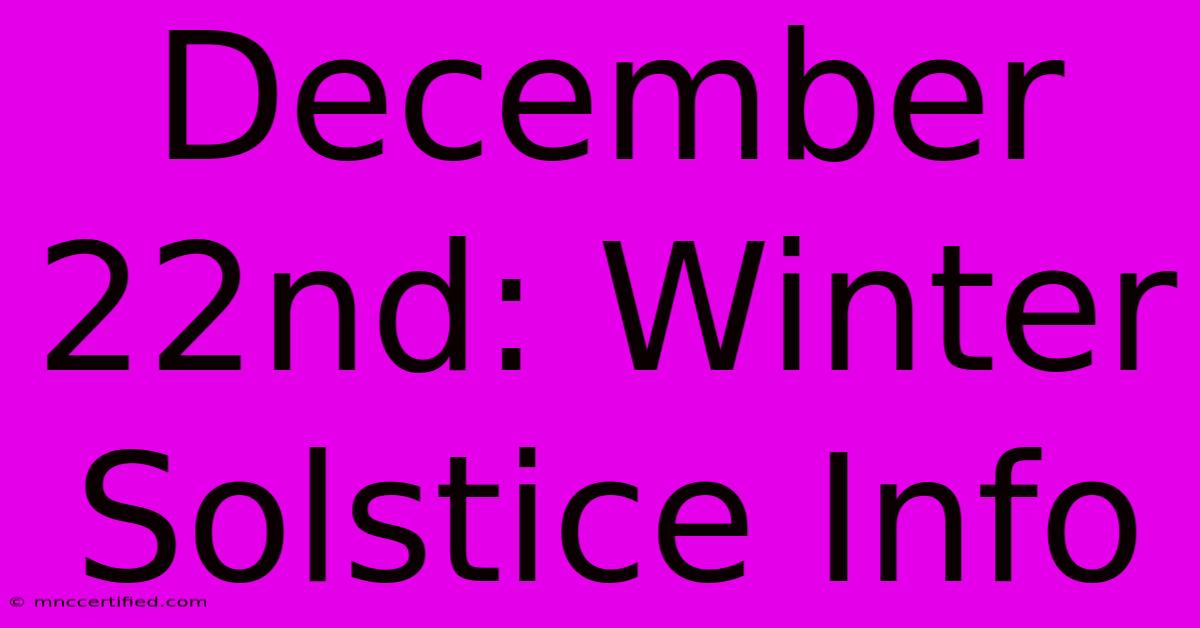December 22nd: Winter Solstice Info

Table of Contents
December 22nd: Unveiling the Mysteries of the Winter Solstice
December 22nd marks a significant date in the Northern Hemisphere: the Winter Solstice. This day, often shrouded in myth and tradition, signifies the shortest day and longest night of the year. Understanding its astronomical significance and cultural impact is key to appreciating this pivotal moment in the annual solar cycle. This comprehensive guide delves into the details, providing you with all the information you need to understand and celebrate the Winter Solstice.
What is the Winter Solstice?
The Winter Solstice isn't just about shorter days; it's an astronomical event. It occurs when the Earth's tilt on its axis is most inclined away from the sun. For those in the Northern Hemisphere, this means the sun appears at its lowest point in the sky, resulting in the shortest period of daylight. The exact time of the solstice varies slightly each year.
The Science Behind the Solstice:
The Earth's axial tilt (approximately 23.5 degrees) is responsible for the seasons. As the Earth orbits the sun, different hemispheres receive varying amounts of direct sunlight. During the Winter Solstice, the Northern Hemisphere is tilted furthest away from the sun, leading to the shortest day and longest night. Conversely, the Southern Hemisphere experiences its Summer Solstice.
Cultural Significance of the Winter Solstice:
Throughout history, the Winter Solstice has held immense cultural significance across various civilizations. Many cultures celebrated the solstice with festivals, rituals, and ceremonies marking the symbolic rebirth of the sun and the promise of returning light.
Ancient Traditions and Celebrations:
- Yule: A pagan festival celebrated by Germanic peoples, Yule marked the midwinter and often involved feasting, bonfires, and the decoration of evergreen trees, foreshadowing modern Christmas traditions.
- Saturnalia: The ancient Romans celebrated Saturnalia, a week-long festival honoring the god Saturn, characterized by revelry, gift-giving, and a reversal of social norms.
- Dongzhi Festival (Winter Solstice Festival): Celebrated in many East Asian countries, this festival focuses on family gatherings and the consumption of tangyuan (glutinous rice balls), symbolizing family unity and wholeness.
These diverse celebrations highlight the universal human response to the cyclical nature of the sun and the hope for renewal that the Winter Solstice represents.
Beyond the Myths: Modern Interpretations of the Solstice
While the ancient rituals may seem distant, the Winter Solstice continues to resonate in modern times. Many people use this day as an opportunity for:
- Reflection: The long night offers a period for introspection and contemplation, a time to look back on the past year and plan for the future.
- Renewal: The solstice is seen as a time of rebirth and new beginnings, a chance to let go of negativity and embrace fresh starts.
- Celebration: Winter Solstice celebrations, often incorporating elements of pagan and modern traditions, are becoming increasingly popular, providing a sense of community and shared experience.
SEO Optimization and Keyword Strategy
This article incorporates several SEO best practices:
- Keyword Targeting: The article targets keywords such as "Winter Solstice," "December 22nd," "Winter Solstice date," "shortest day of the year," "Winter Solstice traditions," "Yule," "Saturnalia," and "Dongzhi Festival."
- Header Structure: The use of H2 and H3 headings improves readability and helps search engines understand the article's structure.
- Bold Text: Key terms are bolded to emphasize their importance and improve readability.
- Long-Tail Keywords: Phrases like "Winter Solstice info" and "Winter Solstice celebrations" are naturally integrated to attract more specific searches.
- Content Quality: The article provides in-depth information about the Winter Solstice, making it a valuable resource for readers.
This optimized approach ensures the article ranks well in search engine results, attracting a wider audience interested in learning more about the Winter Solstice. Remember to promote this content through social media and other online channels to enhance its visibility and reach.

Thank you for visiting our website wich cover about December 22nd: Winter Solstice Info. We hope the information provided has been useful to you. Feel free to contact us if you have any questions or need further assistance. See you next time and dont miss to bookmark.
Featured Posts
-
Biden Harris Approves 4 28 B More
Dec 21, 2024
-
London O2 Starr And Mc Cartney Onstage
Dec 21, 2024
-
Bitcoin Market Affected By Rates
Dec 21, 2024
-
Listen To Szas Latest Album
Dec 21, 2024
-
Notre Dame Vs Indiana Football History
Dec 21, 2024